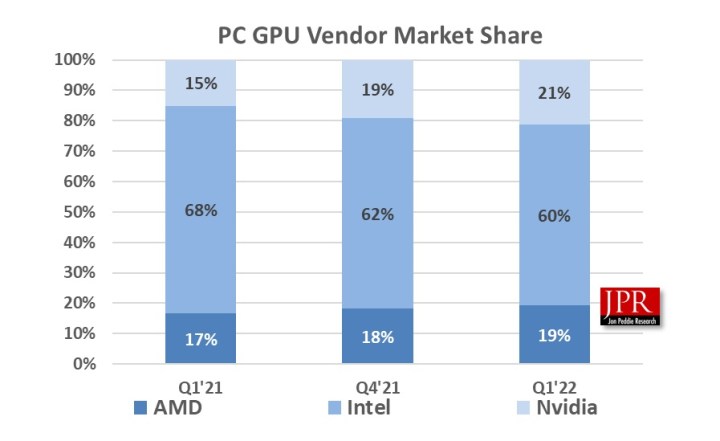A new report from Jon Peddie Research confirms what many of us have been noticing — the demand for graphics cards is finally dropping, and the prices are slowly beginning to normalize.
In the first quarter of 2022, GPU shipments decreased by 6.2% compared to the last quarter of 2021.

Jon Peddie Research prepares periodic reports on the number of shipments of graphics cards and processors, among other things. Throughout the last year, the news was all good for the manufacturers, with increases almost across the board. This time, we’re finally seeing a decrease in GPU shipments, and this includes integrated and discrete graphics solutions from Nvidia, AMD, and Intel.
Breaking down those numbers to reflect how each company fares reveals that Nvidia actually saw a small increase of 3.2% quarter-over-quarter, while AMD had a decline of 1.5%. Intel’s drop was the most significant, as the company saw a decrease of 8.7% compared to the fourth quarter of 2021.
Given that Intel’s share amounts to pre-built PCs and laptops, this implies that these shipment reductions are mostly caused by a drop in the sales of pre-built PCs, and discrete graphics were not as affected. In the fourth quarter of 2022, Intel didn’t have a horse in the discrete GPU race just yet, and even now, it’s still just getting started.
The changes from quarter to quarter are clearly visible, but so are the changes that took place over the span of the entirety of 2021. In the first quarter of 2021, Intel had a large 68% share of the GPU market. Keep in mind that this includes both discrete and integrated graphics, and Intel ships a whole lot of integrated GPUs in its desktops and laptops. AMD had a 17% market share, which can also be attributed in part to integrated graphics. Nvidia only managed to reach 15%, but all of that is discrete graphics.

Comparing the first quarter of 2021 to the first quarter of 2022 nets interesting insights. Intel’s share is down to 60%. Meanwhile, Nvidia managed to work its way to second place, achieving a 21% market share versus AMD’s 19%. Seeing as Nvidia is the only company of the three that focuses solely on discrete GPUs, this means it was a good year for the manufacturer in terms of discrete graphics card sales.
In the first quarter of 2021, the discrete GPU arena only had two competitors: Nvidia with 81% market share and AMD with 19%. Of course, that has now changed — Intel has entered the battle with Arc Alchemist. However, although the company managed to win a small percentage of the market share for the previous quarter, it’s not thanks to Intel Arc, which didn’t make it to market in any considerable quantity before the end of the quarter (and beyond).
As it stands now, the first quarter of 2022 ended with Nvidia at a 78% market share, AMD at 17%, and Intel at 4%. Interestingly enough, the market share that Intel managed to win is entirely thanks to its DG1 graphics solution, which must have found its way into low-end laptops. The next couple of quarters might bring an increase in market share for Intel, but it all depends on the availability of Arc Alchemist GPUs, which have been very scarce.
News like this feels like a breath of fresh air after the last couple of years. The GPU shortage left the market in a pretty bad state, with much more demand for GPUs than the supply chain could ever hope to cover, and, as a result, sky-high prices on the cards that were available. If the trends we’ve been observing continue — and they likely will — we might be able to buy GPUs at MSRP soon enough.




